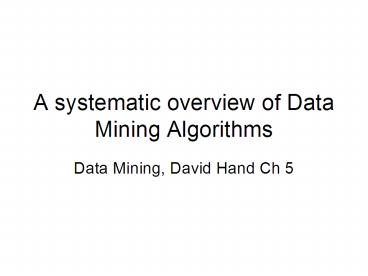A systematic overview of Data Mining Algorithms PowerPoint PPT Presentation
1 / 24
Title: A systematic overview of Data Mining Algorithms
1
A systematic overview of Data Mining Algorithms
- Data Mining, David Hand Ch 5
2
- Input data
- Output models or patterns
3
Data Mining algorithm specification
- Task (visualization, classification, clustering,
regression) - Structure (functional form) of the model that we
are fitting to the data (linear regression,
hierarchical clustering ) - Score function
- Goodness of fit
- Generalization
- Search/optimization method(hill climbing,
simulated annealing, convergence specification )
4
CART classification
- Mapping an input vector x to a categorical class
y - Task prediction (classification)
- Model structure tree
- Score function cross-validation loss function
- Search method greedy local search
5
CART Tree
- Internal node binary test
- Leaf node class
- tree picture p.146
- Data vector x descends a unique path from root to
leaf. - Structure of the tree is derived from the data
- Choose the best variable to split the data
- Score function is misclassification loss
- S C ( y(i), y(i) )
- C is m x m matrix (m is number of classes)
6
Tree classification vs. Linear classification
- Tree can deal with mixed data types (combination
of categorical and real-valued data) - Easier to deal with large number of variables
(because process one at a time)
7
CART tree classification
- Goal of CART is to find a tree closest to optimal
tree - Complex enough to capture the structure
- Not too complex to avoid overfit
- Uses cross-validation technique
8
CART
- Search space is all possible trees (combinatorial
large). - Approximation algorithm Uses greedy local
search to identify good candidate tree
structures - 2 phase
- Recursively expands the tree from root
- Prunes branches
9
Reductionist view on data mining algorithms
- Algorithms are tuples of
- model structure, score function, search method,
data management - When deciding on an algorithm for an application,
think of which components are suitable
10
Multilayer Preceptrons (MLP) for Regression and
Classification
- Non-linear mapping from a real-valued input
vector x to a real-valued output y - Can be used as
- Nonlinear model for regression
- classification
11
MLP Basic idea
12
MLP algorithm tuple
- Task prediction
- Structure layers of nonlinear transformations
of weighted sums of the inputs - Score function sum of squared errors
- Search method steepest-descent from randomly
chosen initial parameter values
13
MLP
- No simple summary (as with a tree)
- Nonlinear nature of its model structure
- Y is a nonlinear function of the inputs
- Parameter ? ( the weights) appear non-linearly in
the score function (?)
14
Score function
- Commonly used Score function
- S S( y(i) y(i))2
- y(i) is a true target value and y(i) is a output
of the network for the ith data point - y(i) is a function of the input vector x(i) and
the weights ? - Training network minimizing S
15
Training methods
- Back-propagation
- Steepest descent on the score function descends
to local minimum given a randomly chosen point in
the parameter space. - Non-linear optimization techniques
16
Tree vs. MLP
- Tree algorithm search through models of different
complexities in a relatively automated manner. - No accepted procedure for network structure of
MLP (number of hidden nodes, layers) - In practice, trial-and-error
17
A Priori Alg. For Association Rule Learning
- Association Rule
- IF A 1 AND B1 THEN C1 with prob p
- A,B,C are binary variables.
- accuracy pa is conditional probability
p(C1A1,B1) - support ps p(A1,B1,C1)
- Specify pa ps as thresholds
- Goal is to find all rules that satisfy threshold
values
18
- Summaries of co-occurrence patterns in the
observed data - Correlation relation, not causation.
19
Association Rules
- Task description associations between
variables - Structure probabilistic association rules
- Score function threshold on accuracy and
support - Search method systematic (BFS) with pruning
20
Example
21
Association Rules Summary
- Systematic search explicitely tries to minimize
number of linear scans through database - Designed to operate on very large data sets.
- Focus on computational efficiency
22
Vector Space Algorithms for Text Retrieval
- Given Query object Q and a large database
- Find k objects that are most similar to Q
- How is similarity defined?
- Reduce documents too a vector representation
- Angle measures similarity
23
- Task retrieval of k most similar documents in a
database relative to a given query - Representation vector of term occurrences
- Score function angle between two vectors
- Search method
- Model representation is the key idea (which terms
to use in a vector)
24
- Statistical approach emphasize theoretical
aspect of inference procedures (parameter
estimation, model selection) - Computer science approach focus on more
efficient search and data mangement.

